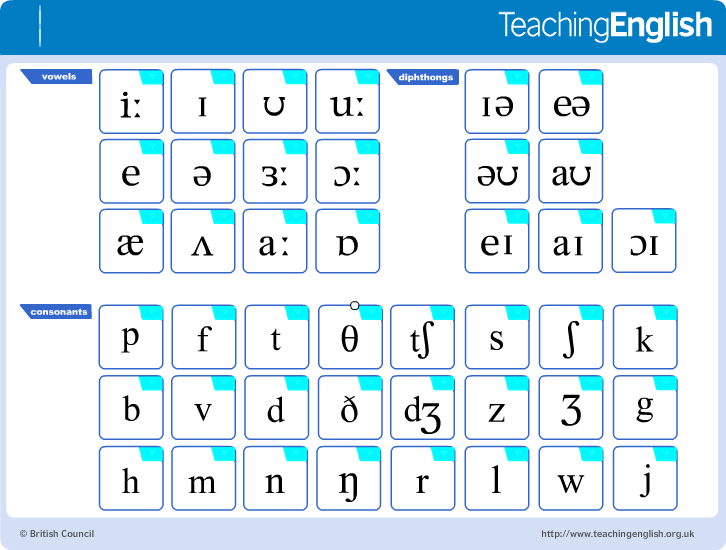English Pronunciation
ENGLISH GRAMMAR & VOCABULARY


Introduction
English pronunciation can be challenging, especially for non-native speakers. One effective way to improve your pronunciation is by using the Phonetic Phonemes Chart. This chart represents the different sounds, or phonemes, in English and provides a visual guide to help you understand and produce these sounds correctly. In this lesson, we will explore the Phonetic Phonemes Chart and provide examples of how to pronounce each sound in different words.
The Phonetic Phonemes Chart
The Phonetic Phonemes Chart is a visual representation of the sounds used in English. It consists of symbols that represent each sound, known as phonemes. These symbols are called International Phonetic Alphabet (IPA) symbols and are used to transcribe the sounds of speech. The chart is divided into three sections: consonant sounds, vowel sounds, and diphthongs.
Interactive Chart here: Interactive Phonemic Chart - UK Speech Academy
Consonant Sounds
The consonant sounds in English are represented by various symbols on the Phonetic Phonemes Chart. Let's look at some examples:
/p/ - Pronounced as in "pat"
/t/ - Pronounced as in "top"
/k/ - Pronounced as in "cat"
/s/ - Pronounced as in "sit"
/f/ - Pronounced as in "fan"
/v/ - Pronounced as in "van"
/z/ - Pronounced as in "zip"
/ʃ/ - Pronounced as in "ship"
/ʒ/ - Pronounced as in "measure"
/m/ - Pronounced as in "man"
/n/ - Pronounced as in "no"
/ŋ/ - Pronounced as in "sing"
/h/ - Pronounced as in "hat"
/l/ - Pronounced as in "lip"
/r/ - Pronounced as in "red"
/j/ - Pronounced as in "yes"
/w/ - Pronounced as in "win"
/dʒ/ - Pronounced as in "judge"
/θ/ - Pronounced as in "think"
/ð/ - Pronounced as in "this"
Vowel Sounds
The vowel sounds in English are represented by different symbols on the Phonetic Phonemes Chart. Let's explore some examples:
/i/ - Pronounced as in "see"
/ɪ/ - Pronounced as in "sit"
/e/ - Pronounced as in "bed"
/æ/ - Pronounced as in "cat"
/ɑː/ - Pronounced as in "car"
/ɔː/ - Pronounced as in "dog"
/ʊ/ - Pronounced as in "book"
/uː/ - Pronounced as in "moon"
/ə/ - Pronounced as in "about"
/ɜː/ - Pronounced as in "bird"
/ɪə/ - Pronounced as in "near"
/eə/ - Pronounced as in "air"
/ʌ/ - Pronounced as in "cup"
/ɒ/ - Pronounced as in "hot"
/aɪ/ - Pronounced as in "time"
/aʊ/ - Pronounced as in "house"
/ɔɪ/ - Pronounced as in "boy"
/əʊ/ - Pronounced as in "go"
/eɪ/ - Pronounced as in "day"
/a/ - Pronounced as in "father"
Diphthongs
Diphthongs are sounds that consist of a combination of two vowel sounds. Here are some examples:
/eɪ/ - Pronounced as in "face"
/aɪ/ - Pronounced as in "light"
/ɔɪ/ - Pronounced as in "coin"
/aʊ/ - Pronounced as in "loud"
/əʊ/ - Pronounced as in "boat"
/ɪə/ - Pronounced as in "here"
/eə/ - Pronounced as in "care"
/ʊə/ - Pronounced as in "tour"
Examples of Pronunciation
Now that we have explored the Phonetic Phonemes Chart, let's look at some examples of how to pronounce these sounds in different words:
Consonant Sound Examples
Word: "pat" - Pronunciation: /pæt/
Word: "top" - Pronunciation: /tɒp/
Word: "cat" - Pronunciation: /kæt/
Word: "sit" - Pronunciation: /sɪt/
Word: "fan" - Pronunciation: /fæn/
Word: "van" - Pronunciation: /væn/
Word: "zip" - Pronunciation: /zɪp/
Word: "ship" - Pronunciation: /ʃɪp/
Word: "measure" - Pronunciation: /ˈmɛʒər/
Word: "man" - Pronunciation: /mæn/
Word: "no" - Pronunciation: /nəʊ/
Word: "sing" - Pronunciation: /sɪŋ/
Word: "hat" - Pronunciation: /hæt/
Word: "lip" - Pronunciation: /lɪp/
Word: "red" - Pronunciation: /rɛd/
Word: "yes" - Pronunciation: /jɛs/
Word: "win" - Pronunciation: /wɪn/
Word: "judge" - Pronunciation: /dʒʌdʒ/
Word: "think" - Pronunciation: /θɪŋk/
Word: "this" - Pronunciation: /ðɪs/
Vowel Sound Examples
Word: "see" - Pronunciation: /siː/
Word: "sit" - Pronunciation: /sɪt/
Word: "bed" - Pronunciation: /bɛd/
Word: "cat" - Pronunciation: /kæt/
Word: "car" - Pronunciation: /kɑːr/
Word: "dog" - Pronunciation: /dɒg/
Word: "book" - Pronunciation: /bʊk/
Word: "moon" - Pronunciation: /muːn/
Word: "about" - Pronunciation: /əˈbaʊt/
Word: "bird" - Pronunciation: /bɜːrd/
Word: "near" - Pronunciation: /nɪər/
Word: "air" - Pronunciation: /ɛər/
Word: "cup" - Pronunciation: /kʌp/
Word: "hot" - Pronunciation: /hɒt/
Word: "time" - Pronunciation: /taɪm/
Word: "house" - Pronunciation: /haʊs/
Word: "boy" - Pronunciation: /bɔɪ/
Word: "go" - Pronunciation: /ɡəʊ/
Word: "day" - Pronunciation: /deɪ/
Word: "father" - Pronunciation: /ˈfɑːðər/
Diphthong Examples
Word: "face" - Pronunciation: /feɪs/
Word: "light" - Pronunciation: /laɪt/
Word: "coin" - Pronunciation: /kɔɪn/
Word: "loud" - Pronunciation: /laʊd/
Word: "boat" - Pronunciation: /bəʊt/
Word: "here" - Pronunciation: /hɪər/
Word: "care" - Pronunciation: /keər/
Word: "tour" - Pronunciation: /tʊər/
Conclusion
The Phonetic Phonemes Chart is a valuable tool for improving English pronunciation. By understanding and practicing the different sounds represented on the chart, you can enhance your ability to pronounce words accurately. Remember to listen to native speakers, practice regularly, and seek feedback to further refine your pronunciation skills. With dedication and practice, you can achieve clearer and more confident English pronunciation.

